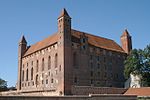Treaties of Cölln and Mewe
The Treaties of Cölln and Mewe, concluded in 1454 and 1455, transferred the
Background
In the second half of the 13th century, the
On September 29, 1402,
On September 8, 1429, the Teutonic Order acquired the pawn as a full possession from
Treaties
On 22 February 1454,

In June, the noble estates of the Schivelbein area approached the Brandenburgian elector for protection against frequent Polish and
On 16 September 1455, another treaty was concluded at the Order's castle in Mewe between Frederick II and Ludwig von Erlichshausen,[20] wherein the Neumark was sold to Frederick for 100,000 Rhenish guilder.[21] The Schivelbein and Driesen areas were explicitly included.[21] The payment of 40,000 guilder resulting from the treaty of Cölln was included in the sum agreed on in Mewe.[13] The Order was granted the right to buy the Neumark back after Frederick II's death.[22] Brandenburg further granted the Order's forces safe conduct.[23]
Aftermath
When by the
In 1517,
Sources
- References
- ^ Leon Rogalski, Dzieje Krzyżaków oraz ich stosunki z Polska, Litwę i Prussami, poprzedzone rysem dziejów wojen krzyżowych, czerpane z najlepszych źródeł, Nakładem i drukiem S. Orgelbranda, 1846
- ^ Philippe MEYER, Une histoire de Berlin, edi8, 11/09/2014
- ^ Henry BOGDAN, Les Hohenzollern, edi8, 13/02/2014
- ^ a b c d Gahlbeck (2007), p. 402
- ^ Ortvay, Band 3 (1894), p.18
- ^ a b c d Heinrich (1992), p. 148
- ^ Ortvay, Band 3 (1894), p.35
- ^ Neugebauer (1996), p. 55
- ^ a b c d Böckler (1995), p. 203
- ^ a b Boockmann (1998), p. 216
- ^ Joachim & Hubatsch (1973), p. 840; Schultze (1989), p. 77
- ^ a b c d Schultze (1989), p. 77
- ^ a b c Gallus (1798), p. 77
- ^ a b Joachim & Hubatsch (1973), p. 840
- ^ Böckler (1995), p. 203; Schultze (1989), p. 77
- ^ a b Hirsch (ADB VII, 1878), p. 479
- ^ Hirsch (ADB VII, 1878), p. 479; Sonthofen (1990), p. 173
- ^ a b Voigt (1860), p. 147
- ^ Amts-Blatt (1865), p. 82 (397)
- ^ Böckler (1995), p. 203; Gallus (1798), p. 77; Schultze (1989), p. 77
- ^ a b Böckler (1995), p. 204; Gallus (1798), p. 77; Neugebauer (1996), p. 55
- ^ Böckler (1995), p. 204; Schultze (1989), p. 77
- ^ Böckler (1995), p. 204
- ^ Sach (2002), p. 307; Schultze (1989), p. 77
- ^ Sach (2002), p. 308
- Bibliography
- Amts-Blatt der Königl. Preuß. Regierung zu Frankfurt a.O., Nr. 51, 1865.
- Böckler, Heidelore (1995). "Die Festigung der Landesherrschaft durch die hohenzollernschen Kurfürsten und der Ausbau der Mark zum fürstlichen Territorialstaat während des 15. Jahrhunderts". In Materna, Ingo; et al. (eds.). Brandenburgische Geschichte (in German). Akademie Verlag. pp. 169–230. ISBN 3-05-002508-5.
- ISBN 3-88680-212-4.
- Gahlbeck, Christian (2007). Archivführer zur Geschichte Ostbrandenburgs bis 1945. Schriften des Bundesinstituts für Kultur und Geschichte der Deutschen im östlichen Europa (in German). Vol. 31. Oldenbourg Wissenschaftsverlag. ISBN 978-3-486-58252-9.
- Gallus, Gottfried Traugott (1798). Geschichte der Mark Brandenburg für Freunde historischer Kunde (in German). Vol. 2.
- Heinrich, Gerd (1992). "Die 'Freien Herren' und das Land. Markgrafenherrschaft und landständliche Einflußnahme im Brandenburg des Spätmittelalters". In Boockmann, Hartmut (ed.). Die Anfänge der ständischen Vertretungen in Preußen und seinen Nachbarländern. Schriften des Historischen Kollegs (in German). Vol. 16. Oldenbourg Wissenschaftsverlag. ISBN 3-486-55840-4.
- Hirsch, Theodor (1878). "Friedrich II., Kurfürst und Markgraf von Brandenburg". ADB (Onlinefassung). Allgemeine Deutsche Biographie (in German). Vol. 7. pp. 475–480.
- Joachim, Erich; Hubatsch, Walter (1973): Regesta historica-diplomatica Ordinis S. Mariae Theutonicorum, 1198-1525, Teil 1, Band 1, p. 840: Verpfändung der Neumark an den Markgrafen von Brandenburg und dessen Hilfe für den Orden, Arnswalde, 13 June 1454. Anlage: Urkunde des Landkomturs Friedrich von Polentz über die Verpfändung der Neumark, 22 February 1454, Abschrift. Listed as PrUB JH I 12913 in Sarnowsky, Jürgen (1999-2009): Das virtuelle Preußische Urkundenbuch. Regesten und Texte zur Geschichte Preußens und des Deutschen Ordens. Retrieved on 8 July 2010.
- Neugebauer, Wolfgang (1996). Die Hohenzollern. Anfänge, Landesstaat und monarchistische Autokratie bis 1740 (in German). Vol. 1. Kohlhammer. ISBN 3-17-012096-4.
- Sach, Maike (2002). Hochmeister und Grossfürst. Die Beziehungen zwischen dem Deutschen Orden in Preußen und dem Moskauer Staat um die Wende zur Neuzeit. Quellen und Studien zur Geschichte des östlichen Europa (in German). Vol. 62. Franz Steiner Verlag. ISBN 3-515-08047-3.
- Schultze, Johannes (1989). Die Mark Brandenburg (in German) (2 ed.). Duncker&Humblot. ISBN 3-428-01376-X.
- Sonthofen, Wolfgang (1990). Der Deutsche Orden. 800 Jahre Geschichte (in German). Rombach. ISBN 3-7930-0588-7.
- Voigt, Friedrich (1860). Geschichte des brandenburgisch-preußischen Staates (in German). Dümmler.
- Ortvay, Theodor (1892). Geschichte der Stadt Pressburg (in German). Stampfel.
